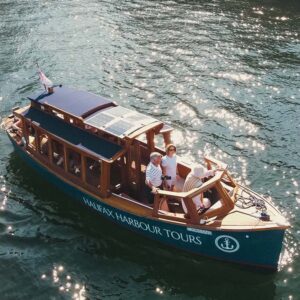Halifax Harbour, nestled along the eastern shores of Nova Scotia, Canada, is a breathtaking natural harbour that has played a vital role in shaping the region’s history, culture, and economy. Stretching over 100 square kilometres, this iconic harbour has been a significant maritime hub since its discovery by European explorers in the early 16th century.
Halifax Harbour: A Quick History
The history of Halifax Harbour is a tapestry woven with tales of exploration, trade, and naval activities. It was in 1749 when the British founded the town of Halifax, choosing this strategic location for its deep waters and protected harbour. The harbour quickly became a crucial naval base and a significant point for British North American colonization. Throughout the centuries, Halifax Harbour has witnessed the arrival and departure of countless ships, from trading vessels carrying goods from across the Atlantic to grand passenger liners ferrying hopeful immigrants to new shores.
Regional Economic Engine
Today, Halifax Harbour is a bustling port, handling a diverse range of cargoes, including goods like timber, seafood, and other commodities vital to the regional economy. The harbour’s modern infrastructure accommodates large container ships, making it a major player in the global shipping industry. At any given time, the waters are alive with the activity of ships coming and going, painting a vibrant picture of a dynamic and prosperous maritime community.
A Hub and a Place to Relax and Unwind
Beyond its economic significance, Halifax Harbour is a haven for both locals and tourists, offering a multitude of recreational activities and breathtaking vistas. Waterfront areas, lined with charming shops, cafes, and restaurants, invite visitors to stroll along the harbour’s edge, savoring the fresh sea breeze. The harbour’s boardwalk, which extends for miles, is a perfect spot for jogging, cycling, or simply enjoying a leisurely walk while taking in the stunning panoramas of the water and cityscape.
One of the most iconic landmarks in Halifax Harbour is George’s Island, situated near the harbour’s mouth. This historical island is home to Fort Charlotte, a star-shaped fortification built in the 18th century to protect the harbour from potential threats. Today, George’s Island is a national historic site and a popular destination for tourists seeking a glimpse into the past.
The harbour is also famous for its connection to the Titanic tragedy. After the ship sank in 1912, rescue vessels set sail from Halifax to recover the victims. The Fairview Lawn Cemetery, located near the harbour, is the final resting place for over one hundred Titanic passengers. Visitors can pay their respects at this poignant site and learn more about this maritime disaster at the nearby Maritime Museum of the Atlantic.
In addition to its historical significance, Halifax Harbour is a sanctuary for marine life and a bird-watcher’s paradise. The harbour’s waters are home to several marine species, including the occasional seals and various fish, while numerous bird species can be spotted gliding gracefully overhead. Conservation efforts are in place to protect the harbour’s fragile ecosystem, ensuring that future generations can continue to marvel at its natural wonders.
As the sun sets over the horizon, casting a warm glow on the harbour’s waters, it becomes evident that Halifax Harbour encapsulates the essence of maritime life, drawing people together through its history, commerce, and beauty.
One of the best ways to experience Halifax Harbour is on board the Violet Mac, Halifax’s only all-electric harbour cruise. Featuring quiet, exhaust-free, one-hour tours of the Halifax waterfront daily from May until the end of October. We offer our standard, public cruise the Halifax Harbour Cruise as well as a 90-minute experience in the morning called Harbour Morning Cruise, and a private evening experience called Evening Skyline.
For more on the history of Halifax Harbour and the city itself visit Halifax archive, Nova Scotia archive, or Discover Halifax.

